A review by Dr Alan Maddison
Abstract
Austerity is associated with physical and mental hardship amongst our most vulnerable, yet George Osborne plans to impose even deeper cuts. The Tories have deceived the public into tolerating such welfare cuts with two false claims. The first was that Labour caused the financial crash in Q1 2008 by overspending on welfare. The second was that only the Tories can be trusted with their sound economic policy of austerity. The evidence shows that both claims are myths.
In fact the bankers crashed our economy at a time when Labour had achieved the best economic performance in the G7 group of countries. Under the Tory Coalition austerity failed, the UK recovery has been the slowest in recorded history, all deficit targets have been missed and the National Debt has almost doubled.
Labour lost the General Election in part because it failed to dispel these Tory myths and so was not trusted on the economy. Jeremy Corbyn was the only Labour leadership candidate to refuse Tory austerity with its selective punishment of the poorest. He offered a credible and fairer alternative to reduce the deficit, gaining approval from many of the mainstream economists. Divisive activities within the PLP need to stop. Given the huge grass-root support for Jeremy Corbyn the PLP need to unite behind their new leader to correct their mistakes, destroy Tory myths, oppose austerity and protect its victims. Labour must win elections but do so it needs to speak out with one strong voice.
Introduction
The price of Tory austerity is not just physical hardship with 4.7 million Britons in food poverty and 100 000 children without a permanent home. There is serious mental hardship too, with documented increases in depression, stress and even suicides, all considered to be related to the imposition of such severe austerity (“Recessions can hurt. But austerity kills” published by David Stuckler, a leading expert on the economics of health).
 Despite such worrying evidence the Tories plan to continue their austerity program with even deeper cuts, apparently unconcerned by the human cost. Yet most economists agree with John McDonnell when he says that Tory austerity is clearly a political choice and not an economical necessity.
Despite such worrying evidence the Tories plan to continue their austerity program with even deeper cuts, apparently unconcerned by the human cost. Yet most economists agree with John McDonnell when he says that Tory austerity is clearly a political choice and not an economical necessity.
So why then isn’t there an even greater public and media outcry?
Probably because the Tories have deceived the public into tolerating welfare cuts with two false claims. The first was that Labour caused the financial crisis in 2008 by overspending on welfare, when the true culprits were the bankers. The second was that such austerity was the only sound economic policy available, when the evidence suggests otherwise.
Subject to this propaganda the public allow the most vulnerable in our society, the poor and disabled, to be severely punished for the mistakes of bankers, whilst the Tory austerity myths accelerates obscene levels of inequality.
Labour could have put an end to such unnecessary misery earlier. But they failed to dispel these powerful Tory myths, lost the General Election in 2015, and so could not then reverse austerity policies and protect its victims.
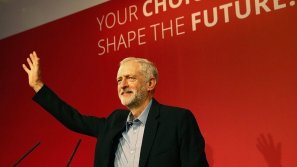 So where does Labour go from here to fight austerity effectively in opposition, and then to win future elections? What lessons have we learnt from events over the last 6 months that could unite Labour from their failure in the General Election in May 2015 to a victory with Jeremy Corbyn.
So where does Labour go from here to fight austerity effectively in opposition, and then to win future elections? What lessons have we learnt from events over the last 6 months that could unite Labour from their failure in the General Election in May 2015 to a victory with Jeremy Corbyn.
I humbly hope to provide some possible answers in this article.
In Section I we explore the lessons that can be learnt from Labour’s failure to win the General Election in 2015. We then examine the reasons for the decisive leadership victory of Jeremy Corbyn. Finally we consider why all the Parliamentary Labour Party (PLP) and Labour members need to unite to fight against austerity both in opposition and in government.
In Section 2 you will find evidence that exposes the Tory myths. In particular we examine evidence concerning austerity, and the relative perfomances of Labour and the the Tories on the economy in terms of GDP growth, Deficit, and National Debt.
Section I
1.1 What lessons can be learnt from Labour’s failure to win the General Election 2015
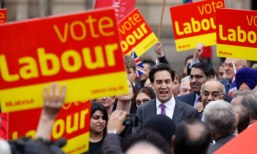
There are certainly many factors that contributed to Labour losing the General Election 2015, but I would like to focus on the issues of austerity and the economy. I have seen a lot of analyses about Labour’s General Election campaign and I’d like to concentrate on a particularly pertinent one by Paul Krugman (Nobel prize-winning economist), actually published before the last General Election.
It is worth reading the full article below (also called ‘The Long Read’!) as Krugman went into a lot of interesting detail.
‘The Austerity Delusion : The case for cuts was a lie. Why does Britain still believe it?’
By Paul Krugman, The Guardian 29th April 2015
Here are some selected quotes;
“All of the economic research that allegedly supported the austerity push has been discredited. More austere countries have a lower rate of GDP growth.
Conservatives like to use the alleged dangers of debt and deficits as clubs with which to beat the welfare state and justify cuts in benefits.
Britain’s opposition has been amazingly willing to accept claims that budget deficits are the biggest economic issue facing the nation, and has made hardly any effort to challenge the extremely dubious proposition that fiscal policy under Blair and Brown was deeply irresponsible – or even the nonsensical proposition that this supposed fiscal irresponsibility caused the crisis of 2008-2009.
But this story isn’t over. Cameron is campaigning largely on a spurious claim to have “rescued” the British economy – and promising, if he stays in power, to continue making substantial cuts in the years ahead. Labour, sad to say, are echoing that position.
So both major parties are in effect promising a new round of austerity that might well hold back a recovery that has, so far, come nowhere near to making up the ground lost during the recession and the initial phase of austerity.
For whatever the politics, the economics of austerity are no different in Britain from what they are in the rest of the advanced world. Harsh austerity in depressed economies isn’t necessary, and does major damage when it is imposed. That was true of Britain five years ago and it’s still true today.
If the political opposition won’t challenge the coalition’s bad economics, who will?
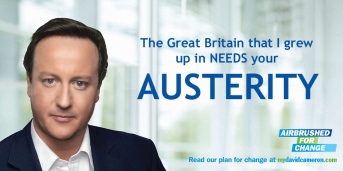
According to Krugman, Labour failed to challenge effectively the Tory’s false arguments on the cause of the financial crash, on austerity economics, and on the relative past economic performances of Labour and the Tory Coalition.
Rather than challenge these myths Labour seemed to ignore them, avoid them, or sometimes adapted their own economic strategy to even accommodate them, offering their own austerity policy!
It meant voters were indeed faced with the two main parties offering a continued austerity with only marginal expressed differences. At the same time, the Tories were allowed to appear as far more credible on the overall economy. This contributed significantly to Labour losing the General Election.
Based on the analyses by Krugman and others, it seems there are indeed important lessons for Labour to take on board for the future.
Labour need to;
a) demonstrate that the economic basis for Tory austerity is now discredited
b) dispel the following Tory myths;
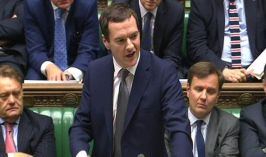 Tory Myth number 1.
Tory Myth number 1.
“Labour caused the financial crisis by borrowing too much and overspending on welfare, and so can’t be trusted with the economy again.”
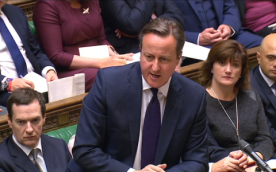
Tory Myth number 2.
” The Tories rescued the economy with austerity after Labour’s failure, and only they can be trusted with the economy in the future.”
c) establish Labour’s proven credibility over the Tory Coalition on the economy.
d) offer a credible and well-differentiated Labour alternative to austerity.
In Section 2, you will find just some of the evidence that was available to expose these Tory myths before May 2015. This evidence should have been better used by Labour and should be used even now as the same powerful myths are still exploited by the Tories.
1.2 Why did Jeremy Corbyn’s anti-austerity policies gain such massive support with Labour’s full-members?
Jeremy Corbyn intelligently redefined the economic debate rather than allowing the Tories to determine the agenda for him. This set him apart from other leadership candidates. He proposed a new Labour economic strategy based on investment for growth and a deficit reduction programme better anchored in the Labour values of social justice.
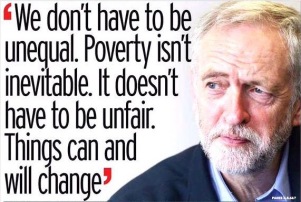 According to Jeremy Corbyn, no longer should the vulnerable and disabled be unfairly punished the most. The rich elite, bankers and Corporations who actually prospered on austerity would be asked to pay their fair share of taxes.
According to Jeremy Corbyn, no longer should the vulnerable and disabled be unfairly punished the most. The rich elite, bankers and Corporations who actually prospered on austerity would be asked to pay their fair share of taxes.
Some in Labour were worried about this inciting possible class war or being seen as anti-business, which could lose Labour the centre ground. However, Yanis Varoufakis, the Greek ex-Finance Minister, said that the Tories, by imposing such austerity, had clearly declared a class war on the poor whilst favouring the rich with tax cuts. Seen in this context, with his anti-austerity economic policies, Jeremy Corbyn was simply correcting an obvious Tory social injustice. He also offered help to small businesses and the increasing number of self-employed who paid all their taxes and yet had little security. So wheras the rather extreme Tory austerity policy is very divisive, Jeremy Corbyn’s anti-austerity policies are more in the centre ground and help unite our country.
The large Corporations often hold Labour to hostage about ‘keeping them happy’. 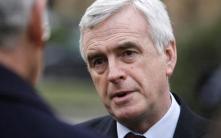 However, as John McDonnell pointed out, businesses had been recipients of £110 billion a year in ‘Welfare’ from the state. Corporations often avoid paying their taxes despite taking advantage of all the state services. Many companies were sitting on large liquidities (£400 billion) but failing to invest for growth. Labour should not be afraid to stand up for the interests of the Nation and insist that Corporations need to contribute more fairly given all the government support they receive. This is not ‘anti-business’, it is simply a policy to re-establish more fairness between Corporations, small businesses, the self-employed, and the rest of our society.
However, as John McDonnell pointed out, businesses had been recipients of £110 billion a year in ‘Welfare’ from the state. Corporations often avoid paying their taxes despite taking advantage of all the state services. Many companies were sitting on large liquidities (£400 billion) but failing to invest for growth. Labour should not be afraid to stand up for the interests of the Nation and insist that Corporations need to contribute more fairly given all the government support they receive. This is not ‘anti-business’, it is simply a policy to re-establish more fairness between Corporations, small businesses, the self-employed, and the rest of our society.

Many Labour Party’s full-members (49.6%) probably understood that Jeremy Corbyn was the only leadership candidate to offer a credible and fairer economic alternative to the Tories who simply wanted to shrink the state with their austerity delusion. Even these full-members gave Jeremy Corbyn more than twice as many votes as for any other leadership candidate (22%). Perhaps the Labour members were more aware of the impact and injustice of Tory cuts than Labour MP’s living in their ‘Westminster bubble’.
I do not believe Jeremy Corbyn voters were mainly ‘hard-lefties’ as there are so many of them. Maybe some felt that the other leadership candidates, despite their talents, had continued to be led off beyond the center ground and towards the right by submitting to the Tory myths and Tory media pressure.

Many supporters may have shared Paul Krugman’s analysis and saw Jeremy Corbyn’s economic policies as mainstream socialist and well differentiated from the Tory offer. Public surveys have indeed shown that most of Jeremy Corbyn’s policies were popular, even the rather leftish ‘nationalisation of the railways’ was favoured by a majority in the general population.
Jeremy Corbyn was also popular because he said he wanted more open debate, including involvement of the grass-roots members. Labour had become too central in its policy-making and this change was refreshing.
Finally, perhaps people are getting tired of too many dishonest and self-serving politicians.
The honest, decent, straight-talking Jeremy Corbyn was like a breath of fresh air!
1.3 How the Parliamentary Labour Party (PLP) reacted to Corbyn’s election.
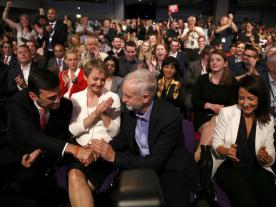
What great news for Labour that tens of thousands of people have been inspired by Jeremy Corbyn and have joined the Labour party which now has around 380 000 members.
Imagine all that extra grass-roots brain-power available to contribute to future Labour policies, all that foot-power to overwhelm the Tories on the campaign door-steps.
Instead of having that energy and enthusiasm harnessed in ‘TeamLabour’ for future victories against the Tories, Jeremy Corbyn’s voters were dismayed to witness many Labour MP’s publicly and immediately refusing to work with their newly elected Leader.
Luckily after a turbulent start, Jeremy Corbyn managed to put together his shadow cabinet team, and there had been positive support for him from many MP’s.
But there was worse to come. Some rebel Labour MP’s frequently abused Jeremy Corbyn’s open-debate policy in order to publicly contradict him, whilst others organised ‘shadow-shadow’ cabinets in their power struggle. Some even selectively trawled internet tweets to deprive him of his advisers. A few Labour MP’s repeatedly sent the media unfair smears about their own leader,
 including vicious lies such as for Remembrance Sunday. They have joined forces with the Tories and their millionaire media moguls in their sustained media campaign designed to incite Jeremy Corbyn’s downfall.
including vicious lies such as for Remembrance Sunday. They have joined forces with the Tories and their millionaire media moguls in their sustained media campaign designed to incite Jeremy Corbyn’s downfall.
David Cameron recently ridiculed Labour in the House of Commons by saying that Jeremy Corbyn did not even have the support of his own Labour MP’s!
How can Labour possibly defend the victims of austerity, or hope to win elections, when Jeremy Corbyn is so disgracefully and publicly undermined by some of his own MP’s?
If these Labour MP’s continue in this divisive way, then Jeremy Corbyn’s Labour will be so weakened that it fails to be an effective opposition and will then lose future elections. It will be the rebel MPs’ betrayal of Labour and the victims of austerity who have already been let down.
The PLP has seemed to be ‘out-of-touch’ with a ‘top down’ approach, which has cost in two general elections, the leadership election, and lost Labour their Scottish majority. Yet they have the peculiar view that it is Jeremy Corbyn who is unelectable! If they continue to treat Labour’s full-members with such contempt they risk rapidly losing Labour the rest of the UK.
It is time for the those silent MP’s to stand up and be counted before the Labour party explodes, given scale of support for Jeremy Corbyn amongst Labour’s full-members.
1.4 What should the PLP do now?
There is a better and more intelligent way forward than division and public betrayal.
If Labour is to win the battles on austerity and other topics in opposition, if they are to win future elections including the General Election of 2020, they have to unite behind Jeremy Corbyn.
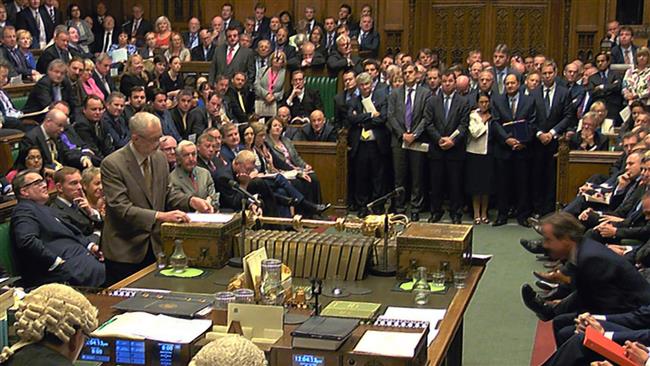
Labour MP’s should debate by all means. Jeremy Corbyn advocates open debate and is unlikely to impose any unpopular policies. They should then respect and campaign on the final agreed policies, speak with a common voice on the main issues, use the media positively to advance Labour policies and ideas, engage and encourage the involvement of the grass roots and respect their views. Crucially they must fight the Tories and demonstrate loyalty for their elected Leader, publicly.
Let me expand on one key concrete example of why Labour’s future unity is so vital.
Example:
In 2010 Liam Byrne MP, the former Labour Treasury Minister left that infamous note ” I’m afraid there’s no money left. Good luck”, for the incoming Tories. The message was not true, it was a joke, but a joke that was allowed to backfire with catastrophic consequences for Labour.
That note has been brandished repeatedly by Cameron to support that myth that Labour had ‘spent all the money’ and were not to be trusted with the economy.
Since then Labour MP’s have allowed the Tories to establish and maintain that important myth (see section 2).
For 5 years the public has believed this lie despite it being crucial to Tory plans to ‘shrink the state’ with a policy of severe austerity. As one journalist wrote ;
” Few people would tolerate such cuts to welfare if they didn’t believe that Labour had borrowed and spent too much. “
Though completely false, it can make sense to the public – if Labour spending too much on welfare was the problem, then making cuts on welfare is the solution.
Incredibly during televised interviews in 2015 two Labour leadership candidates still went along with this overspend myth, so central to Tory communication.
When challenged in Parliament, Cameron, even now, gives his same standard response to Jeremy Corbyn’s questions;
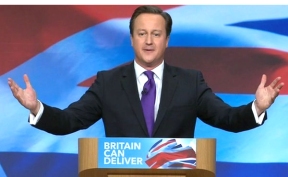 “ ….you’re all the same in Labour, spend, spend, spend. That’s how you crashed our economy in the first place by overspending on welfare. You can’t be trusted. We can only pay for services when the economy is working, we rescued ours after you crashed it, our economy is working under the Tories, we have the fastest growth in the G7…..”
“ ….you’re all the same in Labour, spend, spend, spend. That’s how you crashed our economy in the first place by overspending on welfare. You can’t be trusted. We can only pay for services when the economy is working, we rescued ours after you crashed it, our economy is working under the Tories, we have the fastest growth in the G7…..”
When Cameron gives his ‘mantra’it is repeated faithfully by all his team on the media at every opportuntiy. No wonder the public believe this myth, it has been repeated relatively unopposed for over 5 years!
In order to expose this persistent type of myth now, Labour need the same unity of purpose and coherence of message. The catastrophic public division of Labour today only serve the Tories and the mythologies that support their policies.
Labour must unite to establish the truth with the public on such key issues. The bankers who really caused the crash should not be allowed to prosper on the backs of the innocent poor, vulnerable and disabled who are the most savagely punished by Tory austerity.
Given such an example, we can see that Labour unity is essential to expose these long-standing myths. Labour has to speak firmly with one clear voice on key issues. Only then can Labour hope to rebuild its credibility on the economy.
Labour MP’s must strengthen and not weakenin his efforts to correct earlier mistakes and to win the fight on austerity, in Opposition and then to future election victories.
Section 2
So if Labour MP’s did not adequately challenge Tory myths before the General Election in 2015, what was the evidence at their disposal at the time?
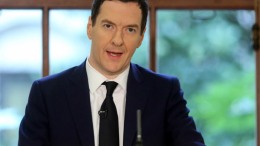 I’d like to review some of this ammunition that could still be used to blow two such Tory myths ‘out of the water’ – as we have seen that the same lies are still being very successfully propagated today.
I’d like to review some of this ammunition that could still be used to blow two such Tory myths ‘out of the water’ – as we have seen that the same lies are still being very successfully propagated today.
2.1 First Tory Myth:
Labour caused the financial crisis in 2008 by borrowing too much and overspending on welfare and so can’t be trusted with the economy.
Sir Mervyn King, the former Governor of the Bank of England, had repeatedly stated that Labour spending did not cause the global financial crash of Q1 2008. In fact he also said that he was surprised that there had not been a greater public outcry against the bankers and financiers who did cause the crash!
The Tories may have tried to blame Labour for the de-regulation of banks. In truth it was a global easing of regulations that the Tories supported fully, and even felt did not go far enough!
You can see in Figure 1 below that when the crash occurred our National Debt (blue line) under Labour was at a very acceptable 38% of GDP – in fact the lowest of any G7 country. The bankers crashed the economy but were given a huge financial support by the tax-payers, (illustrated in red) and estimated now to be around £1500 billion in terms of nationalisations, loans and loan guarantees.
Figure 1. Impact on UK Debt levels of intervention to support the financial sector

The evidence demonstrate the following ;
1. After the initial years of budget surplus Labour needed to increased spending on the NHS to cope with the increased ageing population. In 2003 they also introduced the recently debated Tax Credits and increased the welfare bill. By 2007 these two increases had added £69 billion to their total annual public spending of which £34 billion on welfare.
2. However, despite this increase, Labour did not overspend in 2007/8, quite the opposite. Labour had brought the annual deficit down 40% from £11.5 billion under the Tories in 1996/7 to only £7.6 billion under Labour in 2007/8.
3. In the illustration below (Figure 2.) you can see this also reflected in Labour’s Net Borrowing of only 2.7% GDP (2007/8), once more lower under Labour than that achieved under the previous Tory government (1992-97).
Figure 2. Labour were not overspending prior to the crash in Q1 2008
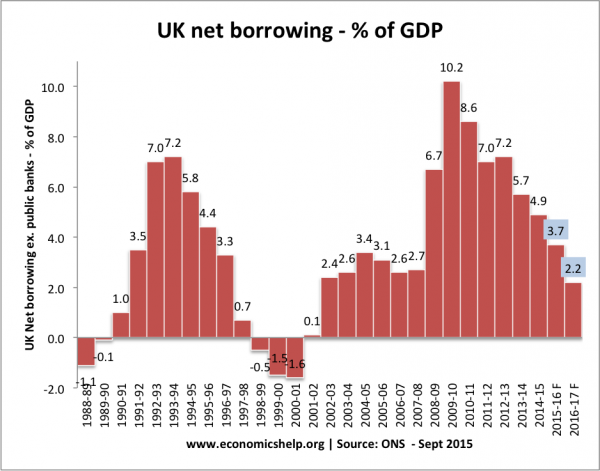
4. The significant increase in borrowing in 2010, about which the Tories still attack Labour, was due to the banking crisis and its devastating effect of pushing the economy into recession. Tax revenues fell and unemployment benefits increased, but a big increase was caused by the massive bank bail-out.
So this evidence shows that the financial crisis and economic crash were caused by bankers and financial institutions. They required a huge bail-out from the tax payer, estimated at £1500 billion. The well-controlled £34 billion increase in welfare spend (including Tax Credits) equates to only 2.3% of the bankers bail-out and in no way contributed to the crash.
Labour should have used the evidence to make the public aware of this first myth. It was planned by the Tories to get the public to tolerate austerity cuts, and to reject Labour on the economy. Having failed to do so before the election, Labour must now establish the true facts.
2.2 Second Tory Myth:
The Tories rescued the economy with austerity after Labour’s failure and only they can be trusted with the economy in the future.
In the following sections we will examine the economic performance of Labour and the Tories/Coalition after the crash.
2.2.1 The impact on the economy of Labour fiscal stimulus and Tory Austerity
Gordon Brown is widely regarded as having managed the dangerous post-crash period extremely well. The Tories though have accused Brown of overspending in 2009 after the crash and having had a large deficit. In fact economists have said the high UK deficit ( 11.4% GDP in 2010) was mostly caused by the dominance of the financial sector, the effects of the recession and the bankers bailout, but not over-spending. In addition, a Labour fiscal stimulus of £20 billion 2009 was part of an agreed G20 economic growth strategy. It was accompanied by spending cuts, and did help grow the economy by 1.9% GDP in 2010.
In June 2010 the Coalition launched an austerity plan with £110 billion of budget cuts, and they cancelled Labour’s fiscal stimulus. In an analysis the OBR showed the positive impact of fiscal stimuli on GDP growth and the negative effect of severe austerity between 2010 and 2013 which led to a double dip recession. As with other international studies it indicates that severe austerity damages growth as shown in Figure 3 below (The actual growth figures have just recently been revised but I do not think this changes the OBR conclusion).
Figure 3. Labour fiscal stimulus grew the economy but Coalition cuts damaged Growth (OBR report)
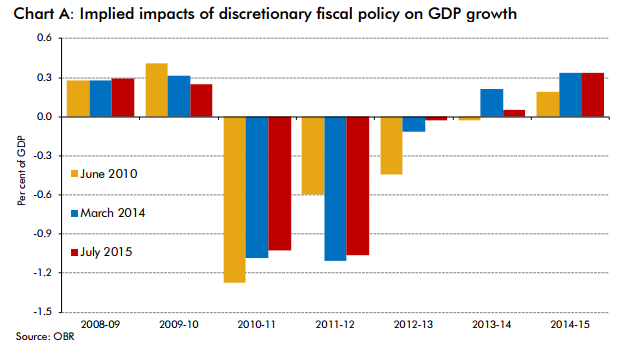
The Labour stimulus of around £20 billion in 2009 was used partly on schools and hospital buildings, training of the unemployed and to support the car industry. It worked.Tories still claim today that Labour left one of the highest deficits in the western world. But if £20 billion investment was an extravagant overspend, according to the Tories, then how do they consider the £1500 billion of tax-payer money used to support the banks that caused the financial crisis in the first place (nationalisations, loans and guarantees), or indeed the tax-payer’s £375 billion of QE that never trickled beyond the financial institutions?
Why do Tories never say that in 2010 Labour handed over to them a growing economy and the lowest National Debt (57% of GDP) of all the G7 countries?
The Tories (albeit in a Coalition) did not want to continue Labour’s economic strategy of balanced cuts across all classes with investment for growth. They did not want to build a better Britain for all. They wanted to shrink the state and perhaps favour the rich elite who financed their party. So they reversed the fiscal stimulus and imposed a severe austerity programme.
Since that time the idea that a policy of austerity after a crisis was supported by reviews of historical data has been discredited. Authors cited by Osborne in 2010, Carmen Reinhart and Kenneth Rogoff (Harvard University), later even denied that their work upheld his austerity.
From a purely economic point of view, severe austerity had never been tested during a period of recession before. Dr Eberhardt (Nottingham School of Economics) set up a study to review of the impact of austerity in 30 high-income democracies. In his report (published April 8th 2015), he concluded that the more severe the austerity, the bigger the negative impact on growth. This confirmed the validity of previous advice from the IMF who questioned chancellor George Osborne’s enthusiasm for ever-deeper budget cuts.
So despite this evidence, did Osborne still rescue the economy with austerity?
I invite you to read an article by Fraser Nelson, The Spectator March 2014 entitled ‘Budget 2014 : The Six Scary Graphs.’
In this excellent article, Osborne’s claims to have an ‘economy that is working’ were quickly shattered.
2.2.2 Osborne responsible for slowest UK recovery in G7 countries.
Osborne claims that in 2014/15 the UK has had the fastest GDP growth in the G7. This may be true but let’s explore the evidence in context of his overall recovery performance.
It is interesting to look at the UK growth performance since 2008 as shown in Figure 4 below.
Figure 4. The UK recovery under Tory austerity is one of the slowest in G7 countries
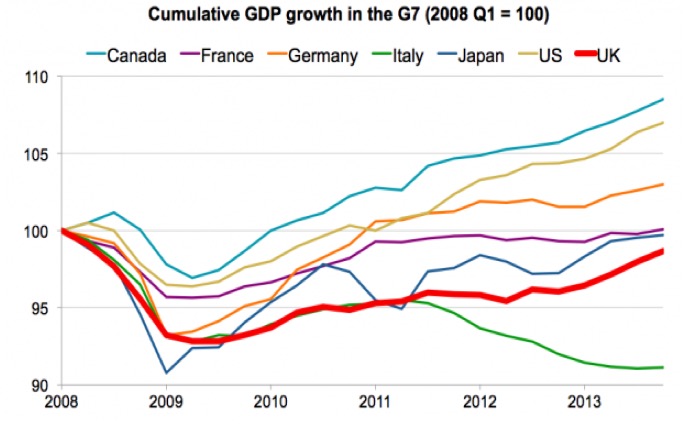
The illustration above shows that any eventual upturn in UK growth for 2014 should be taken in the context of the overall recovery which has been one of the slowest in the G7 as shown. The fastest growth for the UK were in 2010 and 2014 when austerity measures had been eased, perhaps confirming Dr Eberhardt’s work.
Osborne’s recovery has also been the slowest in recorded history for the UK itself. Such slowness is probably related to the negative effect of severe austerity. The recent improvement in UK growth performance has yet to make up for lost time. This is hardly the world-beating performance that Osborne claims.
2.2.3 Osborne missed his key annual deficit targets.
George Osborne claimed he would almost eliminate the annual deficit by 2015 – but he hasn’t. In fact Osborne has missed almost all his set economic targets and deadlines regarding the deficit and the debt, as shown below in Figure 5.
Figure 5. Osborne keeps missing his deficit targets
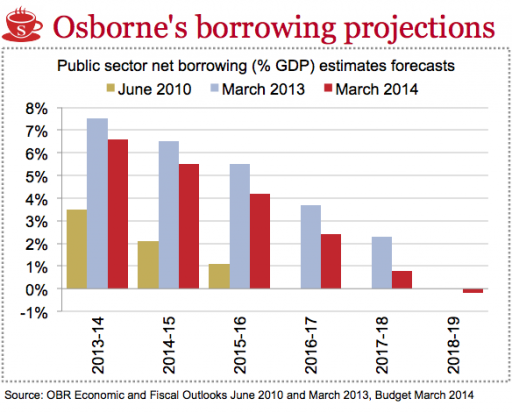
Osborne’s promises on deficit reductions made in June 2010 (in beige above) were nowhere near his real achievements. Osborne has widely missed so many targets that Fraser Nelson said that even the OBR in its own small print wrote “The government is still on course to miss its target. ”
That hardly supports the claim that only the Tories can be trusted with the economy.
2.2.4 Obsorne has doubled the National Debt.
Even worse to come I’m afraid. In Figure 6 below you can see that before the financial crisis in Q1 2008 Labour has brought the National Debt down to 38% of GDP. When handing over to Osborne in Q2 2010 this had risen to 57 % of GDP as a result of the net cost of the recession and the banker’s bail-out.
Figure 6. Osborne has almost doubled the National Debt
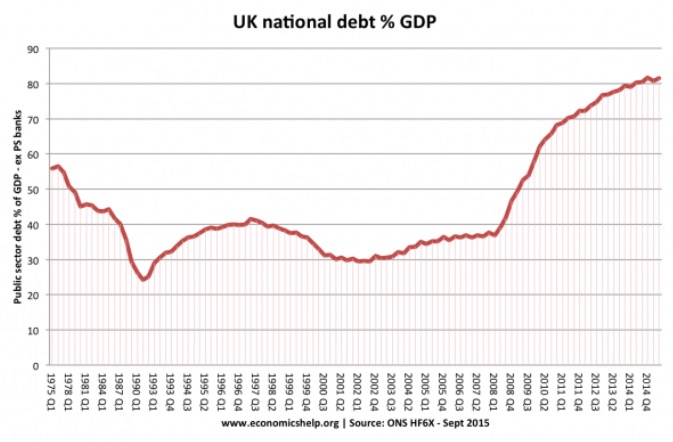
Despite his austerity policies, Osborne managed to almost double the national debt from £811 billion under Labour in 2010 up to £1.5 trillion today. From 57% GDP in 2010 under Labour to over 80% GDP in 2014.
Osborne has borrowed more in 5 years than Labour did in the 13 years which included the financial crash period, yet investments in business have fallen.
2.3 A comparison of international economic performance between Labour and Tories.
Given all the external factors it is difficult to compare the performances between Labour and Tories on the economy but there is no evidence to support the Tory myth about their rescuing the economy from Labour.It could be helpful therefore, to see how Labour and the Tories performed in comparison with other western nations.
2.3.1 Labour achieved the best GDP Growth dynamics recorded in G7 countries.
Figure 7. below illustrates the cumulative GDP growth in the 5 years before the crash under Labour (2003-2007 inclusive) and that in the post crash 5 year period under the Tories (2010-14 inclusive).
Figure 7. Cumulative GDP Growth in G7 Countries
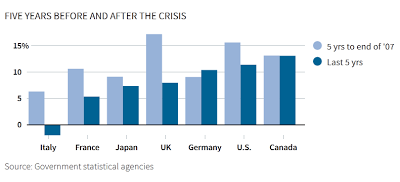
The UK, under a Labour government, prior to the crash, had a higher 5 year cumulative GDP Growth (17.2%) than any other G7 country.
In the 5 year post crash period, the Tory Coalition only managed to recover 46% of the previous Labour growth, yet Canada recovered 100% , USA 73%, Germany even exceeded their pre crash cumulative GDP growth.
During the period 2010-2014, under a Coalition government, as shown above, the UK cumulative GDP growth had dropped from 1st to 4th place in G7 performance.
So we may conclude that the evidence is that the strong relative G7 economic performance on GDP growth achieved under Labour had then declined significantly under the Tories.
2.3.2 Labour achieved the best National Debt/GDP dynamics recorded in G7 countries.
A similar comparative pattern in favour of Labour can be seen in Figure 8 below. In terms of relative performance concerning the National Debt/GDP.
Under Labour up till the crash in Q1 2008 we see that the National Debt/GDP was 38% and this was the lowest of all the G7 nations. The UK leading position had been maintained up till 2010 when they lost office.
Figure 8. UK under Labour had lowest debt of all G7 countries
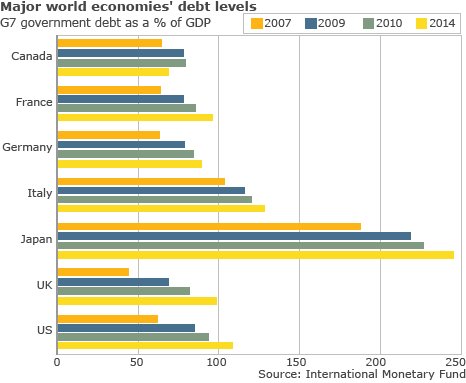
By 2014, despite all the hardships of austerity, Osborne had increased the UK National Debt/GDP ratio to 80% GDP. This moved the UK in the G7 countries down from 1st position in 2007-2010 under Labour, to 4th position in 2014 under the Coalition as shown above.
Figures 7 and 8 above show that Labour achieved the best economic performance amongst G7 countries as measured in GDP Growth or National Debt/GDP ratio. Osborne lost the UK its leading position in both. If anything this indicates that based on past performance Labour can be more to be trusted with the economy than the Tories.
So all the evidence under headings 2.3.1-3 shows that Tory austerity did not rescue our economy as Cameron and Osborne claimed, it failed. The debt has almost doubled and despite recent upturns the overall UK growth has been one of the slowest in the G7.
Labour should have used the evidence to make the public aware of this second myth. It was used by Tories to unfairly damage Labour credibility on the economy. Once more having failed to do so, Labour must now establish the true facts.
Summary
Tory austerity is causing serious hardships especially for the poor and vulnerable. Labour failed to dispel Tory myths about austerity and to establish their credibility on the economy. This contributed to their losing the General Election in 2015 and so to protect the victims of austerity.
The historical evidence reviewed in Sections 1 and 2, demonstrates that Labour’s small increase in welfare spend up to Q1 2008 did not contribute to the financial crash caused by the bankers. During this period Labour had reduced the deficit /debt inherited from the previous Tory government. Despite a high deficit in 2009/10 Labour had achieved the best economical performance of the G7 group in terms of both National Debt and GDP growth. Under subsequent Tory austerity from 2010, the UK growth recovery has been the slowest in recorded history, and the National Debt has almost doubled. Austerity failed.
There is no evidence to support the Tory claim that only they can be trusted with the economy, certainly not with failed austerity policies. In fact if anything Labour credibility on the economy would seem greater.
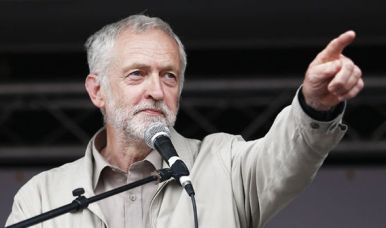 Jeremy Corbyn was the only leadership candidate to seriously challenge austerity and offer a credible and fairer economic policy for deficit reduction and growth. He obtained a massive
Jeremy Corbyn was the only leadership candidate to seriously challenge austerity and offer a credible and fairer economic policy for deficit reduction and growth. He obtained a massive
mandate from Labour’s full members. The PLP needs to now unite behind Jeremy Corbyn to provide a strong and effective voice to protect the victims of austerity, to regain Labour economic credibility and win future election victories.
Conclusion
Now is the time for all Labour MP’s to learn lessons from the recent past. They need to help Jeremy Corbyn correct their previous errors on the economy. Labour must unite to expose the Tory myths and establish the facts in order to provide an effective opposition to austerity, protect its victims and win other elections including the General Election 2020.

Reblogged this on disabledsingleparent.
LikeLike
Tweeted @melissacade68
LikeLike
Thanks for the retweet.
LikeLike
Reblogged this on markcatlin3695's Blog.
LikeLike
Great to see this economic analysis. I completely agree that ‘the myths’ need to be dispelled. As I see it part of the problem the Labour Party faces today is the rejection of everything about New Labour! The great reluctance among many on the left to support Blair in any way shape or form: ( cynicism about ‘peace envoy’, the spin, the lies, the war, the money he has walked away with …) We don’t take on the ‘economic myths’ because we can’t bring ourselves to support much of anything about the Blair years… Is this our achilles heel today?
LikeLike
Thanks for your comments, but I refer mostly to the period between 2010 and 2015. Ed Balls as Labour Shadow Chancellor had worked with Brown and Darling as had Ed Miliband. So they had some ownership of the economical results of that period. Perhaps you have a point about Blair, but I dont think it was the explanation. Some economists did think that Brown had indeed overspent but everybody knew the bankers caused the crash. I can only think the Tory myth communication, supported by the media, was more powerful than the Labour defence. Even during the Labour leadership campaign candidates were challenged my bbc journalists to apologise for that alleged overspend, giving it a proportion it did not deserve, and failing to recognise the economic competence of Labour. It is a worrying rewriting of history that Labour must now expose.
LikeLike
Great piece Alan. New to wordpress or I would have seen this earlier. Recommend Goran Therborn “The Killing Fields of Inequality” One of many books I have read on inequality in the past couple of years but this one I like as it explicitly talks of “distanciation” (Wealth Gap) and if your political elite is drawn from the top 10% (crudely) it leads to harsher public policy. I think we have a chance to change this with the shift in Labour but, as you point out, we need Unity.
LikeLike
Thanks Trish, I agree we need to have unity and speak with a common voice. Especially with what appears as high tory press influence. We need simplified key messages anchored in credible back-up data, and to expose these Tory lies on the economy and Labour competence.
LikeLike